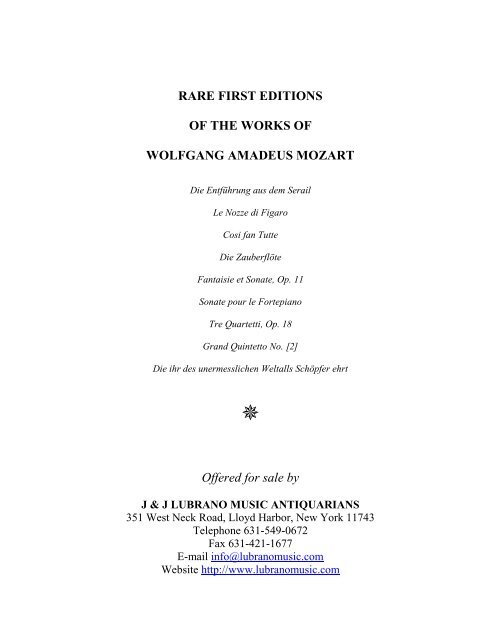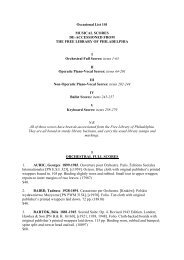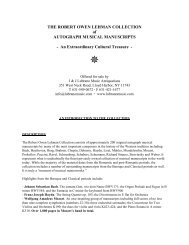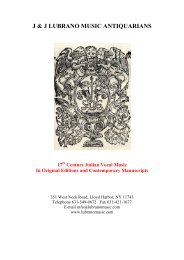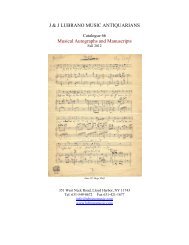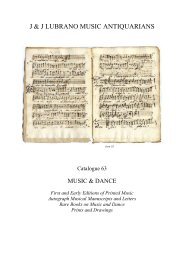RARE FIRST EDITIONS OF THE WORKS OF WOLFGANG ...
RARE FIRST EDITIONS OF THE WORKS OF WOLFGANG ...
RARE FIRST EDITIONS OF THE WORKS OF WOLFGANG ...
You also want an ePaper? Increase the reach of your titles
YUMPU automatically turns print PDFs into web optimized ePapers that Google loves.
<strong>RARE</strong> <strong>FIRST</strong> <strong>EDITIONS</strong><br />
<strong>OF</strong> <strong>THE</strong> <strong>WORKS</strong> <strong>OF</strong><br />
<strong>WOLFGANG</strong> AMADEUS MOZART<br />
Die Entführung aus dem Serail<br />
Le Nozze di Figaro<br />
Cosi fan Tutte<br />
Die Zauberflöte<br />
Fantaisie et Sonate, Op. 11<br />
Sonate pour le Fortepiano<br />
Tre Quartetti, Op. 18<br />
Grand Quintetto No. [2]<br />
Die ihr des unermesslichen Weltalls Schöpfer ehrt<br />
�<br />
Offered for sale by<br />
J & J LUBRANO MUSIC ANTIQUARIANS<br />
351 West Neck Road, Lloyd Harbor, New York 11743<br />
Telephone 631-549-0672<br />
Fax 631-421-1677<br />
E-mail info@lubranomusic.com<br />
Website http://www.lubranomusic.com
OPERAS<br />
DIE ENTFÜHRUNG AUS DEM SERAIL<br />
[The Abduction from the Seraglio]<br />
KV 384<br />
Full Score, First Edition<br />
1<br />
[KV 384]. Die Entführung aus dem Serail Oper in drey Ackten... L'enlevement du<br />
Serail. [Full score]. Bonn: Simrock [PN] 949], [ca. 1813].
Folio. 19th century quarter dark green leather with marbled boards, spine with<br />
titling in decorative compartments gilt. 1f. (title, verso blank), [1]-[2] (blank), 3-<br />
108., 2ff. (blank), 109-272, 2ff. (blank), [273]-350, 1f. (blank). Engraved. With text<br />
in German and French.<br />
Small sewing hole to upper blank inner margin. Previous owner's name and small<br />
handstamp to foot of title. A very good, well-margined copy, printed on high<br />
quality paper with strong impression.<br />
First Edition. Rare. Hirsch II, 639. Sonneck Orchestral Music p. 117. RISM<br />
M4246, MM4246 (a total of 3 copies in the U.S.). Köchel 8 p. 384. Haberkamp I p.<br />
180. Hoboken 11, 141.<br />
First performed in Vienna at the Burgtheater on July 16th 1782, with a libretto by<br />
Johann Gottlieb Stephanie the Younger after Christoph Friedrich Bretzner.<br />
"The most important composition of this period, [1780-1783] however, was Die<br />
Entführung aus dem Serail, the libretto of which was given to Mozart at the end of<br />
July 1781. Originally planned for September, the première was postponed until the<br />
following summer (Mozart had completed the first act in August 1781). The opera<br />
was a great success: Gluck requested an extra performance, Schikaneder's troupe<br />
mounted an independent production in September 1784 (although the aria<br />
‘Martern aller Arten’ was replaced because the orchestra was incapable of<br />
performing the obbligato solos), and productions were soon mounted in cities<br />
throughout German-speaking Europe. The earliest lengthy obituary of Mozart, in<br />
the Musikalische Korrespondenz der Teutschen Filarmonischen Gesellschaft of 4<br />
January 1792, described the work as ‘the pedestal upon which his fame was<br />
erected’." Grove online<br />
"The composition of this opera coincided with Mozart's marriage to Constanze<br />
Weber and his permanent settling in Vienna as a freelance composer and<br />
performer. Despite the intrigues and complications which plagued the premiere, it<br />
proved to be Mozart's most popular opera in his lifetime, partly due to the fashion<br />
for plays and operas on oriental subjects. But it was of this piece that the Emperor,<br />
according to Niemetschek (1798), made his famous comment: 'Too beautiful for our<br />
ears, my dear Mozart, and vastly too many notes', to which Mozart replied 'Just as<br />
many as are necessary, your Majesty'." Robbins Landon: The Mozart<br />
Compendium, p. 249. (18859)<br />
$13,500.
DIE ENTFÜHRUNG AUS DEM SERAIL<br />
[The Abduction from the Seraglio]<br />
KV 384<br />
Piano-Vocal Score, First Edition, 4 th Issue<br />
2<br />
[KV 384]. Die Entführung aus dem Serail Ein komisches Sing-Spiel in drey<br />
Aufzügen... Der Klavier-Auszug von Herrn Abbé Starck. Mainz: B. Schott [PN<br />
44], [after 1785].<br />
Oblong folio. Contemporary half dark brown calf with marbled boards. 1f. (title<br />
within decorative engraved border), 134 pp. Engraved throughout. With individual<br />
titles to each number and incipit to overture. Early ownership inscriptions to titles<br />
("Hohnigl[?]" and "Charlotte Mürsch[...]") and cuts throughout text in orange<br />
crayon and brown ink.<br />
Binding somewhat worn, rubbed and bumped; spine slightly defective. Slightly<br />
worn, soiled and stained; old repair to pp. 29/30; last page trimmed at foot.<br />
First Edition, 4th issue. Haberkamp pp. 178-179 and plate 132 (4. Abzug, with<br />
title as plate 131 with plate number added).<br />
Schott's vocal score of the opera, first issued in 1785 or 1786, was the only edition<br />
of any of Mozart's operas published in complete form during the composer's<br />
lifetime. (19992)<br />
$5,000.
LE NOZZE DI FIGARO<br />
[The Marriage of Figaro]<br />
KV 492<br />
Full Score, First Edition, First Issue<br />
3<br />
[KV 492]. Le Nozze di Figaro Dramma Giocoso in Quattro Atti. [Full score]. Paris:<br />
Magasin de Musique [PN 566, 1-4], [1806-1809].<br />
Two volumes. Folio. Attractively bound in half dark red morocco with marbled<br />
boards in period style. Act I: 1f. (recto title, verso blank), 1f. (recto Table of<br />
Contents, verso blank), [1] (cast list), 2-129, [i] (blank) pp.; Act II: 186 pp.; Act III:<br />
116 pp.; Act IV: [1] (blank), 20-127, [1] (blank) pp. Engraved. With ink handstamp<br />
"Cherubini Mehul et C." to foot of title.
Provenance<br />
From the collection of the English opera singer Willoughby Hunter Weiss (1820-<br />
1867), composer of the famous tune "The Village Blacksmith" to words by Henry<br />
Wadsworth Longfellow, with his small 19th century blindstamp to title and several<br />
pages and the signature in ink of Angelique Weiss to title and first page of third act.<br />
Some minor staining, foxing and offsetting; occasional pencilling.<br />
First Edition, first issue, with number "366" at foot of title and printed price of<br />
"48f." While Köchel (8) p. 545 cites the first edition as having been published in<br />
1795 by Imbault, there are no known copies of this and thus it would seem to be a<br />
"ghost," i.e., a citation for which there is no recorded copy. Fuld p. 353. Hirsch IV,<br />
98. Not in Hoboken. RISM M4339.<br />
First performed in Vienna at the Burgtheater on May 1, 1786, with libretto by<br />
Lorenzo da Ponte after Beaumarchais.<br />
"Figaro is generally agreed to be the most perfect and least problematic of<br />
Mozart's great operas... In the great finales of Acts 2 and 4, Mozart reached a level<br />
which he could never surpass; indeed, he was hardly to equal the Bb Allegro of the<br />
second act finale for its mercurial motivic play and the subsequent Andante in 6/8<br />
for the synchronization of dramatic revelation with the demands of musical form."<br />
Julian Ruston in Grove Opera Vol. 3 p. 634. (19276)<br />
$17,500.<br />
LE NOZZE DI FIGARO<br />
[The Marriage of Figaro]<br />
KV 492<br />
Piano-Vocal Score, First Edition, Unrecorded Issue<br />
4<br />
[KV 492]. Le Nozze de Figaro. Die Hochzeit des Figaro. Eine Comische Oper in 4.<br />
Aufzugen... Ins Deutsche übersetzt von Baron v. Knigge. Und fürs Clavier<br />
eingerichtet von C.G. Neefe. [Piano-vocal score]. Bonn: Simrock [PN] 28, [1796].<br />
Oblong folio. Early dark red leather-backed flexible marbled boards with titling in<br />
manuscript to upper. [1] (title printed within oval decorative border), 2-228 pp., 1f.<br />
(recto publisher's catalogue, verso blank). With stamp of the Hamburg publisher<br />
Günther & Böhme to lower margin of title; publisher's price overstamped with<br />
initials "G & B," price in manuscript of "f14" to lower outer corner.
Provenance:<br />
From the collection of the Dutch composer and conductor Alphons Diepenbrock<br />
(1862-1921), friend of Gustav Mahler, Richard Strauss and Arnold Schoenberg,<br />
with his decorative monogrammatic handstamp in green ink to lower inner corner<br />
of lower board; a pencilled note confirms former ownership.<br />
Binding worn, rubbed, bumped and shaken; head and tail of spine slightly frayed;<br />
portion of front free endpaper lacking. Slightly worn, browned and stained; several<br />
small marginal tears; translation in purple ink to pp. 162-164 cancelled. Quite a<br />
good copy overall.<br />
First Edition, unrecorded issue, possibly contemporary with, or even pre-dating,<br />
the first. Haberkamp p. 257. BUC p. 703. RISM M4343.<br />
Haberkamp states that the second and subsequent issues of Le Nozze contain the<br />
publisher's catalogue listing seven operas by Mozart, the last being Der<br />
Schauspieldirektor; both the first issue and the present copy contain the publisher's<br />
catalogue listing only six of Mozart's operas, the last being Die Zauberflöte. The<br />
present copy differs from the first issue of the score in that the music commences on<br />
the verso of the title rather than on the recto of the second leaf and also in that<br />
neither the pages containing the list of characters and index nor the explanation of<br />
the translation are present. (20006)<br />
$7,500.
COSI FAN TUTTE<br />
[Thus Do They All]<br />
KV 588<br />
Full Score, First Edition<br />
5<br />
[KV 588]. Cosi fan tutte Dramma giocoso in due Atti... Partitura... Weibertreue<br />
oder die Madchen sind von Flandern komische Opera in Zwey Aufzugen. [Full<br />
score]. Leipzig: Breitkopf & Härtel [PN 1363], [1810].
Folio. Half dark blue morocco with raised bands on spine in decorative<br />
compartments gilt, titling gilt to spine. 1f. (title), 3-154, [i] (blank), 155-269 pp.<br />
Engraved. With small oval handstamp of Lichtenberg's Verlag in Stuttgart in light<br />
purple ink to foot of title and verso of final leaf of Act I. Text in both Italian and<br />
German.<br />
Binding slightly worn, rubbed and bumped, minor darkening to edges. Slightly<br />
worn and soiled; very occasional small stains. A very good copy overall.<br />
First Edition of the full score. Hirsch II 633 and Plate XXIII. Sonneck Dramatic<br />
Music p. 116. Hoboken Catalogue Vol. 12, 421 (containing both the text of the<br />
separately-paginated libretto and an additional title preceding the second act, not<br />
found in the present copy). RISM M4693.<br />
Cosi fan tutte, with text by Lorenzo da Ponte, was commissioned by Emperor<br />
Joseph II and first performed on January 26th 1790 at the Burgtheater in Vienna.<br />
Cosi was Mozart's "third collaboration with Da Ponte and the only one of the Da<br />
Ponte operas for which there is no direct literary source (although, like Don<br />
Giovanni, it has sources in Tirso de Molina). It may be that the libretto was wholly<br />
original to Mozart and the poet, for the subject is sometimes claimed to have been<br />
suggested to Mozart and Da Ponte by Joseph II himself, allegedly on the basis of a<br />
recent real-life incident..."<br />
"Così fan tutte is widely reckoned to be the most carefully and symmetrically<br />
constructed of the Da Ponte operas." Cliff Eisen et al in Grove online. (19275)<br />
$9,500.<br />
DIE ZAUBERFLÖTE<br />
[The Magic Flute]<br />
KV 620<br />
First Edition of the Libretto<br />
Exceedingly Rare<br />
6<br />
[KV 620]. Die Zauberflöte Eine grosse Oper in zwey Aufzügen von Emmanuel<br />
Schikaneder. Die Musik ist von herrn Wolfgang Amade Mozart, Kapellmeister,<br />
und wirklichen k.k. Kammer-Compositeur. [KV620]. [Libretto]. Wien: Ignaz<br />
Alberti, 1791.<br />
Small octavo (155 x 95 mm.). Early patterned wrappers. Preserved in a full black<br />
morocco archival clamshell box with gilt titling to spine and insert to upper<br />
depicting one of the two illustrative plates. 1f. (recto title, verso "Personen"), 107,<br />
[i] (blank) pp. + 2 engraved plates by Alberti, being the frontispiece engraving of
the Temple of Isis and Osiris and an engraving of the character "Pagageno" as<br />
performed by the librettist Schikaneder between pp. 4 and 5.<br />
Some (mostly minor) foxing and browning. Occasional professional archival<br />
repairs to wrappers, corners and margins. A very good copy overall.
First Edition. Exceedingly rare. Complete with the two engraved plates<br />
(described above). No copies in U.S. libraries.<br />
Köchel 8, p. 712. Fuld Opera Librettos pp. 348-9 and frontispiece. Hirsch IV, 1385.<br />
Not in Sonneck, Schall, Sesini, Wolfenbüttel or Wolffheim. According to<br />
Warburton in "The Librettos of Mozart's Operas," Vol. 4 (1992), the copies<br />
recorded at both the Austrian and Bavarian State Libraries lack the plates. The<br />
British Library copy has been rebound with the temple plate bound in after page 98.<br />
The Magic Flute was first performed on September 30th 1791 in Vienna at the<br />
Freihaustheater auf der Wieden. Mozart conducted the performance from the<br />
pianoforte with Süssmayr assisting.<br />
"Emanuel Schikaneder, the producer, director, and librettist of Die Zauberflöte, in<br />
which he created the part of Papageno, was a friend of long standing to Mozart<br />
[both Mozart and Schikaneder worked on the libretto in the Spring of 1791]... A<br />
week after the premiere... Mozart returned to witness a performance. He reported<br />
to his wife... that the house was packed as usual, the success enormous, with<br />
several numbers encored." Heartz and Bauman: Mozart's Operas, pp. 255 and 264.<br />
"Although Don Giovanni has often been called sui generis, it is Die Zauberflöte...<br />
more than any of Mozart's other operas that truly deserves this designation. It is his<br />
only opera written expressly for the suburban Freihaustheater auf der Wieden, his<br />
only collaboration with the librettist and actor Emanuel Schikaneder, producer and<br />
director of that theatre, and his only work conceived in the tradition of the magic<br />
operas and 'machine comedies' of the Volkstheater. Although extremely unlike<br />
Mozart's other operas in terms of plot, character and magic effects, Die<br />
Zauberflöte is a natural successor to them in its treatment of Enlightenment themes<br />
and its dramatization of the individual quest for emotional fulfilment. Idomeneo,<br />
Die Entführung aus dem Serail and especially La Clemenza di Tito, which was<br />
composed almost simultaneously with Die Zauberflöte and premiered in Prague<br />
only three weeks earlier, share with Die Zauberflöte an emphasis on virtue,<br />
courage and clemency. It is somehow fitting that Mozart's only fairy-tale opera<br />
complete with imaginary locations, fantastic elements and magic talismans should<br />
also be his most high-minded operatic piece for the stage. For it is only here in the<br />
suburban theatre, which was attended by all ranks of society, that Mozart's<br />
representation of the themes of his age could truly parallel the vast scope of the<br />
Enlightenment, which sought to include all of mankind in its sweeping reforms."<br />
Eisen and Keefe: The Cambridge Mozart Encyclopedia, p. 540. (18839)<br />
$32,500.
<strong>WORKS</strong> FOR PIANO<br />
FANTAISIE ET SONATE, Op. 11<br />
KV 475 and KV 457<br />
First Edition, 3 rd Issue<br />
7<br />
[KV 475 and KV 457]. Fantaisie et Sonate Pour le Forte-Piano composées pour<br />
Madame Therese de Trattnern par le Maitre de Chapelle... Oeuvre XI [KV 475 and<br />
KV 457]. Vienne: Artaria [PN] 70, [ca. 1785].<br />
[i] (title), 2-23, [i] (blank) pp. Engraved. Occasional early annotations, mostly in<br />
pencil, including corrections.<br />
Rare. First Edition, third issue, with page 7 in the original state and the first<br />
movement of the Sonata marked "Allegro molto." Kochel-Einstein 6 pp. 515 and<br />
497. Haberkamp p. 236 (Text-Band) and p. 199 (Bild-Band). RISM M6810 (the<br />
Library of Congress copy only in North America).<br />
"Mozart's masterly C-minor Sonata bears this handwritten dedication: "Sonata. For<br />
Piano solo. Composed for Mrs. Theresa von Trattner by her most humble servant<br />
Wolfgang Amadeus Mozart. Vienna, 14 October 1784." It remains a generous<br />
tribute to his talented twenty-six-year-old pupil, the wife of a Viennese book<br />
publisher and entrepreneur. To add to its power, Mozart himself prefaced it with a<br />
fantasia in the same key, completed seven months later, in May 1784…"
"This fantasia is so complete in itself that it is difficult to think of it as a "prelude,"<br />
although Mozart published it together with the C-minor sonata, K. 457, that he had<br />
written in the previous year. It contains five sections: Adagio, Allegro, Andantino,<br />
Più Allegro, and Tempo I, in the last of which the opening Adagio returns in a<br />
relentless form to round off the whole piece." Zaslaw, ed.: The Compleat Mozart,<br />
pp. 313 and 324.<br />
Bound with:<br />
Sonate pour Le Clavecin ou Piano-Forte... Oeuvre [K. 310]. Vienna: Artaria &<br />
Comp. [PN 370] [ca. 1795]. 17, [1] (blank) pp. First Edition, second issue of the<br />
first separate edition. Kochel-Einstein p. 320. RISM M6767 (only one copy of this<br />
issue recorded).<br />
"Compositions in minor keys are rare in Mozart's works… Among the several<br />
explanations that have been suggested, the most prevalent perhaps is that the death<br />
of Mozart's mother on July 3, 1778, after a short, unforeseen illness, gave rise to a<br />
deep sense of loss… Or perhaps it was the enforced absence from Aloysia Weber,<br />
the young Mannheim soprano with whom he had recently fallen in love, that drove<br />
him toward a more turbulent minor-keyed creativity. This A-minor work ushers into<br />
the sonatas a vibrant emotional intensity…". Zaslaw pp. 310-311.<br />
Bound with:<br />
Rondeau No. I [& III] pour le Piano-Forte [K. 511 and K. 616]. Leipzig: Bureau de<br />
Musique [PN] 145 [209] [1803]. 7; 7 pp. RISM M6845 (no copies recorded in<br />
North America).<br />
"This rondo [K 511] is a work of such harmonic daring that it prophesies aspects<br />
of Schubert and of Chopin... [K 616] is the last of Mozart's three pieces for<br />
mechanical organ. It is a rondo in A-B-A-C-A-B-A form of considerable proportion<br />
and elaborate filigree." Zaslaw pp. 325-326.<br />
Oblong folio. Nineteenth century quarter dark brown leather with dark red<br />
decorative embossed boards, raised bands on spine in compartments gilt, "Sonaten<br />
von Mozart" gilt to upper.<br />
Binding slightly worn, rubbed and bumped; rear joint split. Several tears repaired;<br />
some spotting; several leaves cropped with occasional slight loss of printed area.<br />
(19898)<br />
$7,500.
SONATE POUR LE FORTEPIANO<br />
KV 481<br />
First Edition, First Issue<br />
8<br />
[KV 481] Sonate pour Le Fortepiano, ou Clavecin avec Accompagnement d'un<br />
Violon. [Parts]. Vienne: Hoffmeister [PN] 28, [1786].<br />
Unbound. Keyboard: [1] (title), 2-17, [i] (blank) oblong folio; violin: 5, [i] (blank)<br />
pp. upright folio.<br />
Slightly worn and soiled; title and last leaf of keyboard part separated and of violin<br />
part nearly so; occasional very small stains.<br />
First Edition, first issue. Haberkamp p. 244, plate no. 204. Hirsch IV, 90.<br />
Hoboken 11, 247. RISM M6543 (one copy only recorded in the U.S.), not<br />
distinguishing between issues.<br />
Completed in Vienna on December 12, 1785.<br />
"The Sonata in E-flat major is certainly one of the most mature works in Mozart's<br />
whole chamber music output. The three movements are in complete balance with<br />
one another, each having its own structural principle and each starting with an<br />
individual interpretation of one of the oldest and commonest thematic principles:<br />
the major triad. The exposition of the first movement contains three clearly outlined<br />
subjects. The Adagio, in A-flat major, is a rondo with two episodes and varied<br />
repeats of the principal subject; it is full of romantic modulations. The Finale, a set<br />
of variations on a leisurely theme twenty measures in length, brings the desirable<br />
relaxation after the emotional tension of the Adagio." Zaslaw and Cowdery p. 297.<br />
(21460) $7,500
<strong>WORKS</strong> FOR STRING QUARTET<br />
TRE QUARTETTI, Op. 18<br />
KV 575, 589 and 590<br />
First Edition, 4 th Issue of the “Prussian Quartets”<br />
9<br />
[KV 575, 589, and 590]. Tre Quartetti per due Violini Viola e Basso... Opera [18].<br />
[Parts]. Vienna: Artaria e Compagni [PNs 360 and 361], [ca. 1791].<br />
4 volumes. Folio. Early marbled wrappers. Preserved in a custom-made green cloth<br />
folder with slipcase with dark red leather label gilt to spine. [1] (title within<br />
decorative border), 2-20; [1] (blank), 2-19; [1] (blank), 2-17; [1] (blank), 2-17 pp.<br />
Engraved. Plate number "360" to pp. 4-7 of first violin part only.<br />
Slightly worn and thumbed; inner margin of title guarded just affecting edge of<br />
printed border; occasional markings in pencil and crayon.<br />
First Edition, 4th issue of the Prussian Quartets. Haberkamp Text p. 326. BUC<br />
p. 709. RISM M6169 (not distinguishing among issues).<br />
"The Prussian Quartets, K. 575, 589 and 590, form a group, since they are<br />
dedicated to King Friedrich Wilhelm in Berlin, who played the violoncello - or at
least they were written with an eye towards such a dedication, for the first edition<br />
bears no dedication at all. The royal virtuosity had to be taken into account, and so<br />
in almost every movement of the three works the violoncello has a predominant<br />
part, while the second violin and viola retreat into the background. The quartets<br />
are slightly concertante, and yet they are purest chamber music. Mozart sometimes<br />
completely forgets his royal patron - as for instance in the minuet of the last<br />
quartet. These are three works that originated under the most dreadful spiritual<br />
oppression, and yet they rise to heights of pure felicity." Einstein: Mozart, p. 184.<br />
(20758)<br />
$5,500.<br />
<strong>WORKS</strong> FOR STRING QUINTET<br />
GRAND QUINTETTO No. [2]<br />
KV 516<br />
First Edition, 5 th Issue<br />
10<br />
[KV 516]. Grand Quintetto per due Violini due Viole e Violoncello... No. [2].<br />
[Parts]. Vienna: Artaria et Comp. [PN 315], [1799].
Folio. Disbound. [1] (title), 9; 8; 1f. (blank), 9; 1f. (blank), 7; 1f. (blank), 7 pp.<br />
Engraved.<br />
Slightly worn, soiled and foxed.<br />
First Edition, 5th issue. Haberkamp Text p. 285. BUC p. 708. RISM M5990 (no<br />
copies recorded in the U.S.).<br />
"This is the most famous of the quintets. Its very special key, its dramatic power, its<br />
combination of tragedy and tenderness have assured it a unique place in the<br />
chamber-music repertoire. Together with the great G-minor Symphony, K. 550<br />
(completed July 25, 1788), it constitutes the most personal music, perhaps, that<br />
Mozart ever wrote." Zaslaw & Cowdery, eds.: The Compleat Mozart A Guide to the<br />
Musical Works, p. 255. (21565)<br />
$2,200.<br />
CANTATAS<br />
DIE IHR DES UNERMESSLICHEN WELTALLS SCHÖPFER EHRT<br />
KV 619<br />
Piano-Vocal Score, First Edition<br />
11<br />
[KV 619]. Die ihr des unermesslichen Weltalls Schöpfer ehrt. [KV 619]. [Pianovocal<br />
score]. Contained in Ziegenhagen, Franz Heinrich (1753-1806): Lehre vom<br />
richtigen Verhältnisse zu den Schöpfungswerken, und durch öffentliche Einführung<br />
derselben allein zu bewürkende algemeine Menschenbeglückung... mit einer Musik<br />
von W.A. Mozart. Hamburg: bie dem Herausgeber, 1792.<br />
Octavo. Contemporary marbled boards. 1f. (title), 3ff., [1]-633 [!631], [i] (blank)<br />
pp. + 8 engraved pictorial plates by the Polish/German painter and printmaker<br />
Daniel Chodowiecki (1726-1801), two of which are folding, + 8 pp. typeset music<br />
printed on 4 folding leaves.<br />
Binding slightly worn and scuffed. With errors in pagination to text; two tears<br />
repaired including one to a large folding plate; repair to lower blank margin of pp.<br />
183/184; small burnhole to pp. 559/560 just affecting several letters. A very good,<br />
crisp and clean copy overall.<br />
First Edition. Köchel 8, p. 706. Haberkamp I, p. 352. RISM M4161 and MM4161.<br />
Both Mozart and Ziegenhagen were Masons. "In the summer of 1791, F.H.<br />
Ziegenhagen, a merchant from Hamburg who belonged to a lodge in Regensburg,
commissioned this setting of his own text for solo voice and piano from Mozart. The<br />
six movements of the "little German cantata" are brief and continuous, mixing<br />
arioso and recitative, and passing through a variety of moods. The style both of this<br />
work and of K.623 shares the clarity, directness, and euphony of The Magic Flute."<br />
Zaslaw and Cowdery: The Compleat Mozart, p. 38.<br />
The present study is an early and important treatise on utopian socialism,<br />
proposing the establishment of self-sufficient agricultural/educational colonies; the<br />
fine engravings by Chodowiecki illustrate daily life in these idealized colonies and<br />
include classroom and agricultural scenes.<br />
The text of the cantata relates to the ideals proposed in Ziegenhagen's study.<br />
(21220)<br />
$5,500.


